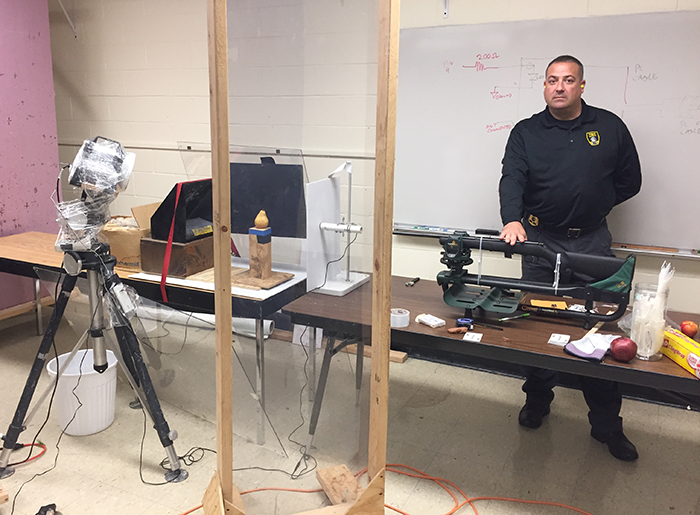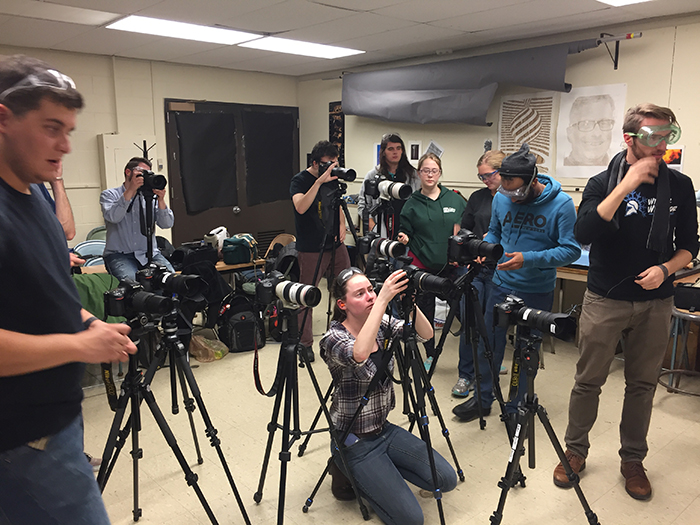From the Classroom: High Speed Ballistics Photography at RIT
Written By Ted Kinsman
Photographic Sciences
email Ted
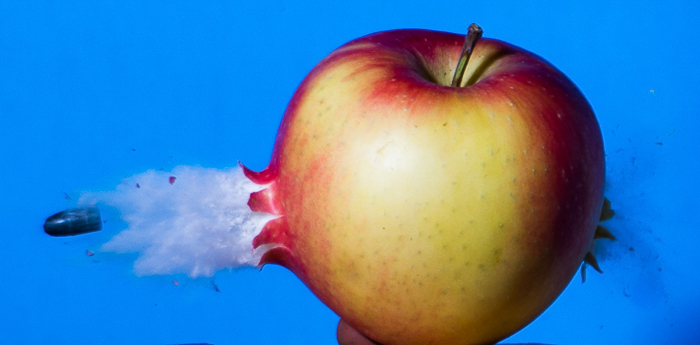
This picture records a .22 caliber bullet moving at 1,200 feet per second as it travels through an apple in the classic high-speed picture. Photograph by Nasser Albahri.
The high-speed imaging class, offered by the photographic sciences department, has a long standing tradition of photographing bullets in flight. As one of the few schools that teach students the skills required to create images like these, I thought it would be worthwhile to explain the equipment and the procedures that we use at RIT.
Although the program has enjoyed a long history of ballistics photography, we recently updated our safety standards required to safely discharge a firearm in a classroom on a University campus. Our protocols were established in conjunction with the Monroe County Sheriff and Public Safety. The protocol requires a RIT safety officer certified in firearms to be the only individual to handle and operate the firearm in the classroom. The firearm used in the lab is a .22 caliber bolt-action rifle. The bolt can easily be removed from the rifle, which allows a laser to be aimed and positioned down the barrel. This is the quickest way to insure the alignment of the bullet and the target. When not in use, the rifle is stored in a locked gun safe under the supervision of public safety and only brought into the lab when a ballistics assignment is being preformed.
The rifle is securely mounted to a gun vise that keeps the barrel aligned with a ballistics sensor, manufactured by Mumford Micro Systems®, which is used to trigger a time machine camera controller. The ballistic sensor is made up of two infrared (IR) detectors mounted 4 inches apart. When a bullet traverses in front of the two IR sensors, a microcontroller activates the high-speed flash at a specific time when the bullet is down range from the rifle. The accuracy of the trigger system is so precise that the location of a bullet only varies by a few millimeters shot-to-shot.
Tony Yazback, is the RIT public safety officer responsible for handling the rifle. As the bullet passes through the white tube, it interacts with the ballistic sensor. A white piece of foam core stops a lot of the gun shot residue from getting in the air and making a mess. The pear evident in the frame is the target. The bullet is stopped by the bullet trap held in place with a red strap on the table. The Spot Flash is wrapped in Saran wrap® to protect the lens and the flash trigger is on tripod below the flash. The subject is located behind a large Plexiglas shield.
For increased safety, the bullet is stopped by a bullet trap that is only a few inches outside the camera frame. The closer the bullet trap is to the target, the lesser chance the subject will cause splattering. This greatly decreases the mess and allows a much easier cleanup after the laboratory. The high-speed flash used in these images is a Spot Flash manufactured by Prism Science Works . The flash is an air gap flash that generates a clean flash with a duration of 500ns. Fast enough to easily stop a .22 caliber bullet.
After the rifle is positioned in the jog, used to trigger the ballistic sensor, the students are ready to photograph objects that they have brought to lab. The safety officer has final approval what can be used for the lab. Fruits and vegetables are acceptable, but hard objects such as plastic snow globes or alarm clocks are rejected because of the off chance of a ricocheted bullet. To guard against any unforeseen ricochets, the students are required to stand behind two large Plexiglas screens. Students are also wear safety glasses and ear protection during the lab.
Shown above, students align their cameras and check their exposures before the experiment begins. Camera shutters are kept open and allow the fast flash to stop the action creating the exposure.
The students use an open shutter technique to capture the images. The subject to be photographed is located on a small stand located in the action field. The position is adjusted to take into consideration how the bullet will slow down going through the target. The flash is triggered by hand to evaluate the exposure and focus. After the students all have focused and set the camera’s exposure settings, the rifle is loaded. The room lights are turned out, the camera shutters are opened, the safety officer fires the rifle, and then camera shutters are closed. Only after all the camera shutters are closed, are the room lights turned on again are the exposure checked. Using this procedure, all involved experience limited risk and safely allowing the production of amazing high-speed images.
Students from the photographic sciences program find employment at a number of industries that utilize high-speed imagery. Former students are now employed by NASA, Sandia Laboratories, and The Insurance Institute of Highway Safety.
A video of the class lab can be found at:
https://vimeo.com/album/3781288/video/190300234
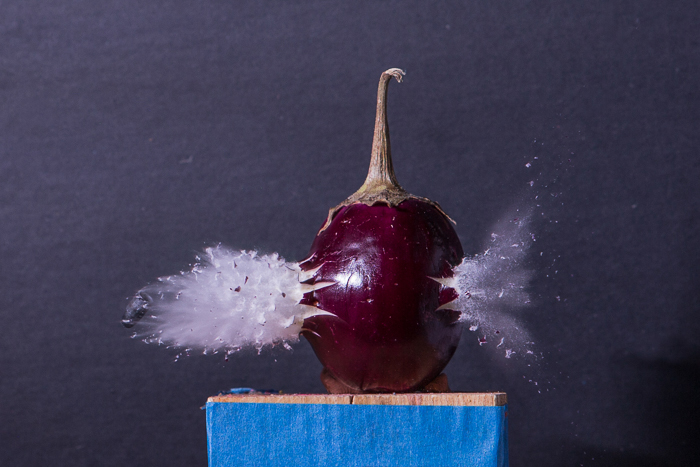
Eggplant Photograph by David Lopez
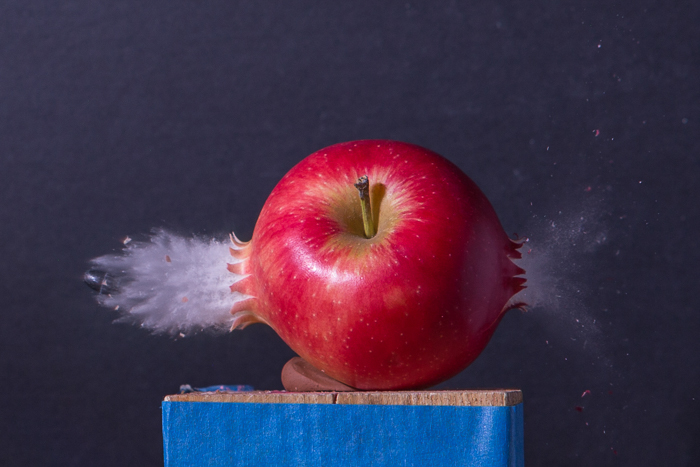 Apple Photograph by David Lopez.
Apple Photograph by David Lopez.
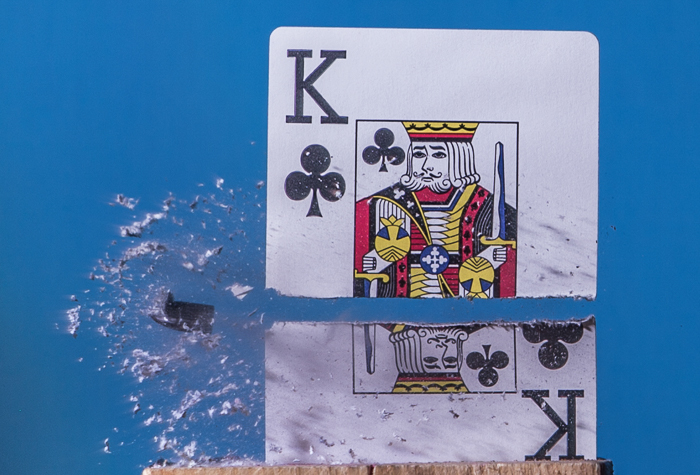 Playing card photograph by David Lopez.
Playing card photograph by David Lopez.
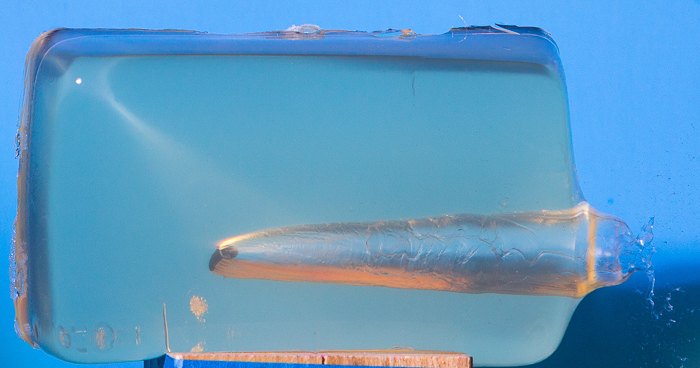 Homemade ballistics jello is just uncolored jello made at three times the normal strength. Note the bullet is moving sideways in this photograph. Photograph by David Lopez.
Homemade ballistics jello is just uncolored jello made at three times the normal strength. Note the bullet is moving sideways in this photograph. Photograph by David Lopez.
I would like to extend special thanks to the following people that make this unique lab possible. Christopher Denninger and Anthony Yazback (RIT Public Safety), Melinda Ward, risk management, Professor Michael Peres, Dr. Therese Mulligan, and Amanda Kearney (video supervision). I would also like to thank the students in the class for sharing images used in this short article.
